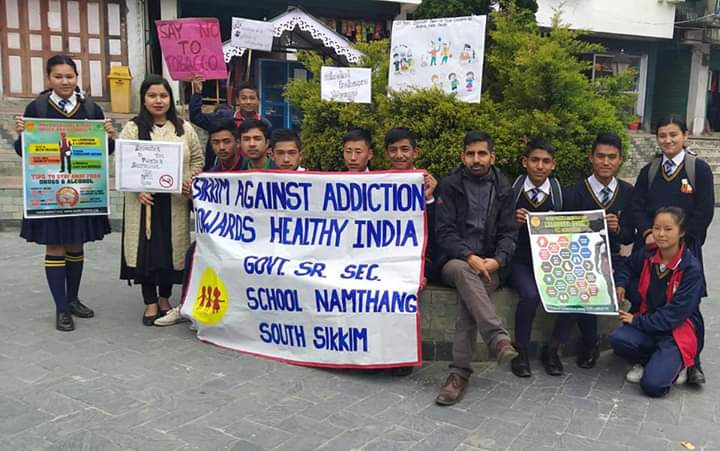SAATHI - A novel initiative to tackle substance abuse
- Ravi
- Mar 1, 2014
- 4 min read
Battling substance abuse through peer-education in Schools

The proximity of the northeast region to three of India’s neighbors, Bangladesh, Bhutan and Myanmar, aided by borders having difficult terrain and the presence of numerous insurgent groups and drug trafficking cartels makes Sikkim vulnerable to the threat of drug abuse through increased access.
But it is probably a deeper social malaise that is the main reason for the increase in addiction, prompted by a cultural acceptance of alcohol consumption as innocuous. Several studies support this assumption. Some even put per capita alcohol consumption of Sikkim 3rd highest in the country.
Contrary to the belief that there is scarce research on substance abuse in the state, institutes within and outside are actively involved in various studies.
Adolescents, aged between 10 and 19 years, are one of the most vulnerable groups who fall prey to drug addiction. Adolescents and youth have an inclination to experiment and rebel against norms, making them perfect targets for a ‘high’ - seeking escape from their routine. It is also important to note that, usually; substance abuse is not a solitary indulgence. People resort to substances when in groups, sometimes to even conform to the group.
There is compelling evidence indicating that adequate prevention and treatment of depression and substance abuse can reduce suicide rates. Increasing suicides in the state are being attributed to substance abuse, mental illness, depression followed by failure in examination and love affairs.
Sikkim has witnessed rapid growth and massive urbanization over the last decade, disrupting traditional family structures and socio-economic patterns. The evidence for imitative suicides is also well documented. WHO in their publication “Preventing Suicide - A Resource for Media Professionals” has given detailed guidelines regarding the role of media. Alarmingly in Sikkim, editors often choose to put suicide related news on the front pages of their publications – something that WHO recommends against.
The problem of substance abuse can only be tackled with a two-pronged approach.
First, the supply of substances has to be curtailed. This is achieved through providing necessary legislative framework and ensuring better policing. Those who have already been victims of drug-abuse need addiction treatment and counseling. The State Government enacted the Sikkim Anti-Drugs Act, popularly known as SADA in 2006. This legislation was enacted to prohibit the contraband substances not covered in the national legislation. The Sikkim Excise Act was amended to introduce harsher punishment to those who sell alcohol to children below 18 years. De-addiction and rehabilitation centers have been set up in the state. There is tight vigil by the police at the various check posts in the State. In their citizen charter, the police even request the people to inform them in case of “Sale and distribution of drugs or psychotropic substance abuse especially by young members”. The CATCH program even attempts to screen the population for depression, people with suicidal tendencies and those who have attempted suicide, and refers them to appropriate center for management.
But neither the police nor the de-addiction centers can act as panacea for this complicated issue. Hence, the second prong - focusing on improving the mental health of people from a young age. The most prudent and probably the only way to turn the problem around is tackling it from the demand side. Kids must be educated on the various ill effects of substance abuse. One way to do this – make kids keep an eye on each other.
This is exactly what the peer-mentoring program SAATHI has been doing over the past one year – building on a simple, yet extremely powerful concept. SAATHI aims to bring under one roof all the people already involved in fighting substance abuse.
SAATHI is customized to the needs of Sikkimese society. The program creates peer educators and counselors at the school level through sustained training on life skills and guided monitoring. Since its launch, necessary support structures have been built, from school level to professional psychiatrists. A pilot program, launched in two schools last year, was completed in December 2013.
Lessons were learnt and more importantly, visible impact was made. Now after considerable success, SAATHI is ready to be scaled up to 10 schools, covering all 4 districts. By 2015, the aim is to extend the program to all the Government schools in the State.
The number of peddlers arrested under SADA shows a slow but steady rise. There has also been a high suicide rate in the State. There have been cases where women were booked under SADA for peddling drugs. These are just a few indicators of the extent and peculiarity of the problem. Sikkim has to continue its war against substance abuse till it is completely wiped out. Attributing one single factor to such a complex mental health issue would be naivety. The political will has been clearly demonstrated through the various steps that have been taken, including SAATHI. But even SAATHI would need adequate support from the society and its stakeholders to realize its vision - to make Sikkim free of substance abuse.
Note: This article was first published in the Political and Economic Journal of Sikkim in March 2014. Official website of SAATHI is https://saathisikkim.org

Comments